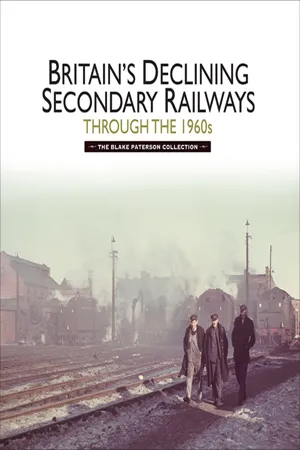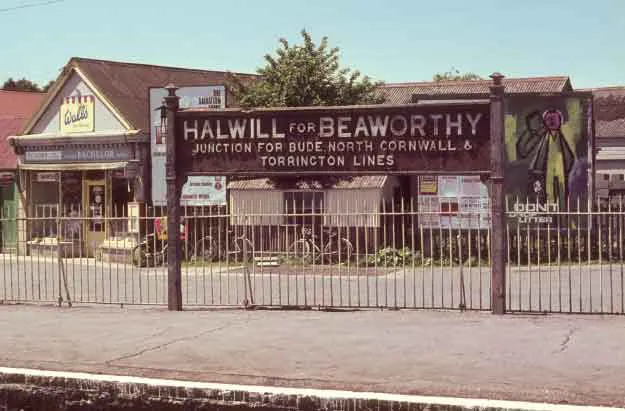![]()
Blake visited Cornwall on 28 May 1966 to record trains on the former Bodmin & Wadebridge Railway built in 1834 and a pioneer user of steam traction. The line was acquired by the London & South Western Railway (LSWR) in 1847 and was connected to the Great Western Railway (GWR) line to Bodmin for Bodmin Road in 1888 and extended westwards to Padstow in 1899. Following nationalisation of the railways in 1948, the former LSWR terminus at Bodmin was renamed Bodmin North and the ex-GWR terminus became Bodmin General. This view shows Nanstallon Halt, four miles east of Wadebridge looking towards Bodmin, and depicts a Western Region (WR) single-car diesel unit. The halt was opened by the LSWR on 2 July 1906 and later acquired a GWR ‘Pagoda’ shelter. The line closed to passengers on 30 January 1967.
In an unsuccessful attempt to make the Wadebridge-Bodmin services more sustainable two exchange platforms were installed at Boscarne Junction so that passengers from Bodmin North and Dunmere Halt could transfer to Bodmin General to Wadebridge trains. The Bodmin North shuttle, journey time five minutes, was introduced from 14 June 1964 and was operated by two railbuses, Nos.W79977 and W79978, belonging to a batch of five built by AC Cars of Thames Ditton with AEC engines. These had operated on the Tetbury and Cirencester branches from Kemble in Gloucestershire from 2 February 1959 until these lines closed on 4 April 1964. When the Bodmin shuttles were withdrawn on 30 January 1967, both railbuses were transferred to the Scottish Region. On his 28 May 1966 visit, Blake photographed one of these railbuses at Dunmere Halt, close to Dunmere Junction (think Wenfordbridge and Beattie tanks!). The halt displays its LSWR origins with the use of concrete posts but, like Nanstallon Halt, it later acquired a GWR Pagoda hut. The heritage Bodmin & Wenford Railway has reopened the line from Bodmin Parkway (formerly Bodmin Road) to Boscarne Junction via Bodmin General. Nanstallon and Dunmere halts are still in situ, improving the Camel Trail multi-purpose pathway, though you won’t see any humpback animals! Camel is the name of the local river and valley.
Trains from Bodmin reached Padstow via Wadebridge, which was also the junction with the North Cornwall Railway from Halwill in Devon via Launceston and Camelford. This line, operated by the LSWR from the outset, was built in stages between 1886 and 1899 and closed on 3 October 1966, four months before the Wadebridge-Padstow line from Bodmin. Camelford station, towards the western end of the Halwill line, optimistically infers proximity to Boscastle and Tintagel but was nowhere near anywhere, not even Camelford town! One of Blake’s interests was to record aspects of the vanishing infrastructure and on 28 May 1966 the station looks well past its prime.
Another station photographed on 28 May 1966 was Tresmeer, the second station east of Camelford. Opened on 28 July 1892 it was located near the delightfully named hamlet of Splatt, not to be confused with Splott that is a district of Cardiff.
Still proceeding eastwards, the station between Tresmeer and Launceston was Egloskerry, which on 28 May 1966 was typically deserted, apart from railway staff, one of whom, on the opposite platform, may be the signalman going to the hand-operated level crossing gates. The Halwill-Padstow line was never well patronised but it reflected the LSWR’s desperation to reach Cornwall to challenge the GWR’s monopoly in that county and to connect with its own Bodmin-Wadebridge-Padstow line. Latterly there were just four through trains in each direction on weekdays plus a morning run from Launceston to Hallwill and a return working in the evening. The narrow gauge Launceston Steam Railway now operates along 2½ miles of the North Cornwall Railway from Launceston to Newmills and hopes to extend to Egloskerry. The station houses at Camelford, Tresmeer and Egloskerry survive as private residences.
Further up the North Cornwall coast from Padstow is the seaside town of Bude, which was the terminus of a branch from Okehampton in Devon, diverging from the Padstow via Camelford line near Halwill Junction. Initially the LSWR built the line only as far as Holsworthy, opening the station in 1879, and provided a bus service to Stratton and Bude. The residents of those habitations pressed the LSWR to extend the railway, which they did nineteen years later, but decided on a more direct and less costly route avoiding Stratton, which, at the time, had a larger population than Bude. On 1 June 1963 Standard Class 4 2-6-4, No.80064 stands ready to leave Bude for Okehampton on one of eight weekday departures. Now no trace remains of the station, the railway land being covered by houses with an address of Bulleid Way. This commemorates the designer of West Country Pacific No.34006 Bude, the naming ceremony having taken place at Bude station on 1 November 1945. However, it is doubtful whether many residents on the estate know the significance of their road name, but at least they have been spared the more prosaic Beeching Close!
The Bude branch was transferred from the Southern Region (SR) to the WR on 1 January 1963 and, to save money, staff numbers were reduced and diesel units introduced from September 1964. The only intermediate station on the Holsworthy-Bude extension was Whitstone & Bridgerule and a single-car ‘bubble’ car unit is seen there on 28 May 1966 heading for Bude. Although Whitstone is in Cornwall and Bridgerule is in Devon, any county rivalries were disregarded in the context of this ‘joint’ station that stood just inside Devon and opened on 1 November 1898. The main station building, with its canopy intact, is now a private house and although the trackbed has been filled in, the platform edges are visible. Sadly, the two original LSWR enamel station signs on each platform, which surprisingly were still in place when passenger services were withdrawn, have been removed. The one pictured here on 1 June 1963 was located on the Bude platform opposite the main building and close to the road bridge.
After Holsworthy, travelling east, the next station on the Bude branch was Dunsland Cross, where the station nameboard invited passengers to alight for Shebbear College. The station opened on 20 January 1879 when the terminus of the Bude line was Holsworthy. The branch was single track with passing loops at the stations, hence the second platform. Once, long cattle trains had used this line as well as a portion of the ‘Atlantic Coast Express’ that ran on summer Saturdays until September 1964 but, by the time of Blake’s visit on 28 May 1966, only local services operated and Dunsland Cross station was showing signs of neglect, including the partial collapse of a section of platform. The main station building survives as a bungalow.
Making his way east towards Okehampton on 28 May 1966, Blake alighted at Maddaford Moor Halt for Thorndon Cross. There he recorded passengers using the line, something which occurred all too infrequently, and which inevitably made the branch a target for the Beeching Axe. This primitive station was something of an afterthought as it did not open until 26 July 1926, forty-seven years after the line to Holsworthy was built. The sign on the extreme left attached to the ‘station building’ reads ‘Waiting Shed’, which is an apt description of the structure!
Three lines bifurcated at Halwill, as stated on the running-in board photographed on 28 May 1966. These were the LSWR’s Bude Branch, the North Cornwall Railway to Launceston, later extended to Padstow, and the North Devon & Cornwall Light Railway to Torrington. The station closed to passengers on 3 October 1966 and the site has been redeveloped for housing, which includes a road inevitably called Beeching Close.
This scene at Halwill was taken on an earlier visit on 1 June 1963 when it was well endowed with signals. The train has a goods van in the middle, indicating it is formed of two portions, which would have originated from Padstow and Bude. The Bude section has arrived first, the locomotive subsequently running round its train and hauling the coaches on to the Bude branch until the Padstow section arrived. The Bude engine would then propel the coaches onto the back of the train for the onward journey, probably to Exeter Central. Judging by the empty Post Office trolley being pushed over the crossing, the combined train has probably been loaded with parcels. It is hauled by Maunsell Class N 2-6-0, No.31874, one of eighty built, and the sole representative of the class to have the good fortune to end up at Woodhams scrapyard at Barry. Consequently it is the only one preserved, its latest home being on the Swanage Railway.
One of the least profitable passenger lines in the country was that from Torrington to Halwill Junction, which was opened by the North Devon & Cornwall Junction Light Railway as late as 1925. This was the last standard gauge line built in North Devon and was constructed in p...













